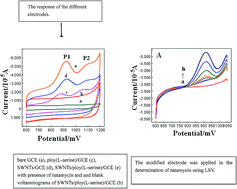Sensitive determination of natamycin based on a new voltammetric sensor: a single-walled carbon nanotube composite poly(l-serine) film modified electrode†
Abstract
A novel voltammetric sensor, based on a single-walled carbon nanotube (SWNT) composite poly(L-serine) film modified electrode, was fabricated by simple dipping–drying and electrodeposition methods and used for highly sensitive determination of natamycin. At this sensor, the electrochemical response of natamycin was improved greatly due to the synergistic effect of SWNTs and poly(L-serine). A new voltammetric method for the determination of natamycin was proposed with a detection linear range of 6 × 10−8 mol L−1 to 6 × 10−6 mol L−1 and a detection limit of 4 × 10−8 mol L−1. Furthermore, the electrode reaction of natamycin was investigated in detail and some dynamic parameters were calculated for the first time. Using the present method, the residual quantity of natamycin in available claret and beverage samples was evaluated with good satisfactory recovery.


 Please wait while we load your content...
Please wait while we load your content...